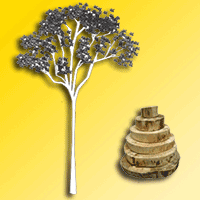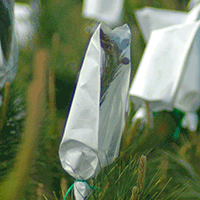Poplar plantations cover 31.4 million ha around the world and supply timber for paper, sawn wood and other wood-based products. In each region where poplars are planted, it is possible to identify “model clones” which are massively adopted by foresters. Improving the rationale of clone selection in breeding programs requires a comprehensive understanding of the physiological traits that explain the differences in genotypes growth. Moreover, given that growth is related to the use of resources (water, light and nutrients) we also need to determine which morphological and physiological traits explain the model condition of most widespread clones. A controlled-condition study was carried out to evaluate eight Populus deltoides and two Populus × canadensis clones, including the model Populus deltoides €˜Australiano 129/60’. For each clone, physiological and morphological traits related to biomass partitioning (roots, stem and leaf dry mass), growth (height, diameter), light use (leaf area duration, leaf size, net photosynthetic rate), water use (stem hydraulic conductivity, water consumption) and nutrient use (nitrogen and phosphorus concentrations) were measured. High variability in the physiology and morphology was observed among clones, and similar and contrasting clones in relation to the model clone were identified. Similarities among clones varied depending on the characteristic being evaluated at the time-water use, light use or nutrient use. The results showed that variability not only relates to visible phenotype, but also to functionality. This information is significant since the breeding programs can evaluate non-traditional traits and select genotypes which are similar or complementary to the model clone. The characterization of model clones is key for breeding programs which seek new candidates taking into account the use of water, nutrients and light. It is also important because it helps explain why foresters prefer one clone over others. Knowledge about functional variability within clones of the same species enables foresters to conduct more intelligent and site-specific silviculture and to optimize the genotype selection in breeding programs.
Keywords
, , , ,
Citation
Bonnin SM, Alvarez JA, Faustino LI, Graciano C (2024). Revealing the physiological basis of forester’s choice of poplar clones (Populus spp.). iForest 17: 156-164. - doi: 10.3832/ifor4433-017
Academic Editor
Andrea Cutini
Paper history
Received: Jul 21, 2023
Accepted: Feb 27, 2024
First online: Jun 14, 2024
Publication Date: Jun 30, 2024
Publication Time: 3.60 months
© SISEF - The Italian Society of Silviculture and Forest Ecology 2024
Open Access
This article is distributed under the terms of the Creative Commons Attribution-Non Commercial 4.0 International (https://creativecommons.org/licenses/by-nc/4.0/), which permits unrestricted use, distribution, and reproduction in any medium, provided you give appropriate credit to the original author(s) and the source, provide a link to the Creative Commons license, and indicate if changes were made.

Breakdown by View Type
(Waiting for server response...)
Article Usage
Total Article Views: 9115
(from publication date up to now)
Breakdown by View Type
HTML Page Views: 5520
Abstract Page Views: 1594
PDF Downloads: 1761
Citation/Reference Downloads: 0
XML Downloads: 240
Web Metrics
Days since publication: 551
Overall contacts: 9115
Avg. contacts per week: 115.80
Article Citations
Article citations are based on data periodically collected from the Clarivate Web of Science web site
(last update: Mar 2025)
(No citations were found up to date. Please come back later)
Publication Metrics
by Dimensions ©
Articles citing this article
List of the papers citing this article based on CrossRef Cited-by.
(1)
Al Afas N, Marron N, Ceulemans R (2006)Clonal variation in stomatal characteristics related to biomass production of 12 poplar (
Populus) clones in a short rotation coppice culture. Environmental and Experimental Botany 58: 279-286.
CrossRef |
Gscholar
(2)
Alvarez JA, Cortizo SC, Gyenge JE (2020)Yield stability and phenotypic plasticity of
Populus spp. clones growing in environmental gradients: I-yield stability under field conditions. Forest Ecology and Management 463: 1-8.
CrossRef |
Gscholar
(3)
Azad M (2012)Observations on bud burst phenology in a field trial established with Poplar (
Populus spp.). Forestry Studies in China 14: 251-259.
CrossRef |
Gscholar
(4)
Barrio-Anta M, Sixto-Blanco H, Cañellas I, De Viñas R, Castedo-Dorado F (2008)Dynamic growth model for I-214 poplar plantations in the northern and central plateaux in Spain. Forest Ecology and Management 255: 1167-1178.
CrossRef |
Gscholar
(5)
Bonnin SM, Faustino LI, Alvarez JA, Graciano C (2020)La combinación de clones posee alguna ventaja sobre los sistemas monoclonales? [Does clones combination have any advantage in comparison to monoclonal systems? Silvicultural alternatives for Salicaceae, based on the review of previous experiences]. Revista de La Facultad de Agronomía 119: 1-11. [in Spanish]
CrossRef |
Gscholar
(6)
Boyden S, Binkley D, Stape JL (2008)Competition among eucalyptus trees depends on genetic variation and resource supply. Ecology 89: 2850-2859.
CrossRef |
Gscholar
(7)
Broeckx LS, Vanbeveren SP, Verlinden MS, Ceulemans R (2015)First
vs. second rotation of a poplar short rotation coppice: leaf area development, light interception and radiation use efficiency. iForest 8: 565-573.
CrossRef |
Gscholar
(8)
Cao X, Jia JB, Li H, Li MC, Luo J, Liang ZS, Liu TX, Liu WG, Peng CH, Luo ZB (2012)Photosynthesis, water use efficiency and stable carbon isotope composition are associated with anatomical properties of leaf and xylem in six poplar species. Plant Biology 14: 612-620.
CrossRef |
Gscholar
(9)
Costa Silva EF, Shvaleva A, Maroco JP, Almeida MH, Chaves MM, Pereira JS (2004)Responses to water stress in two Eucalyptus globulus clones differing in drought tolerance. Tree Physiology 24: 1165-1172.
CrossRef |
Gscholar
(10)
Dietrich L, Hoch G, Kahmen A, Körner C (2018)Losing half the conductive area hardly impacts the water status of mature trees. Scientific Reports 8: 1-9.
CrossRef |
Gscholar
(11)
Dillen SY, Rood SB, Ceulemans R (2010)Genetics and genomics of
Populus. In: “Plan Genetics and Genomics: Crops and Models” (S Jansson, R Bhalerao, A Groover eds). Springer Science and Business Media BV, New York, USA.
CrossRef |
Gscholar
(12)
Donnelly L, Jagodzinski, Grant OM, O’Reilly C (2016)Above- and below-ground biomass partitioning and fine root morphology in juvenile Sitka spruce clones in monoclonal and polyclonal mixtures. Forest Ecology and Management 373: 17-25.
CrossRef |
Gscholar
(13)
Faustino LI, Rodríguez ME, Alvarez JA, Doffo G, Cortizo S, Graciano C (2016)Rendimiento y extracción de nutrientes en estaqueros de álamo del Delta del Paraná fertilizados con nitrógeno o fósforo [Yield and nutrient extraction from poplar nurseries fertilized with nitrogen or phosphorus]. Revista de La Facultad de Agronomía 115: 179-190. [in Spanish]
Gscholar
(14)
Feng J, Jiang D, Shang H, Dong M, Wang G, He X, Zhao C, Mao K (2013)Barcoding poplars (
Populus L.) from Western China. PLoS One 8: 8.
CrossRef |
Gscholar
(15)
Fichot R, Laurans F, Monclus R, Moreau A, Pilate G, Brignolas F (2009)Xylem anatomy correlates with gas exchange, water-use efficiency and growth performance under contrasting water regimes: evidence from
Populus deltoides × Populus nigra hybrids. Tree Physiology 29: 1537-1549.
CrossRef |
Gscholar
(16)
Fortier J, Truax B, Gagnon D, Lambert F (2015)Plastic allometry in coarse root biomass of mature hybrid poplar plantations. Bioenergy Research 8: 1691-1704.
CrossRef |
Gscholar
(17)
Fortier J, Truax B, Gagnon D, Lambert F (2017)Linking biomass productivity to genotype-specific nutrient cycling strategies in mature hybrid poplars planted along an environmental gradient. Bioenergy Research 10: 876-890.
CrossRef |
Gscholar
(18)
Fossati T, Zapelli I, Bisoffi S, Micheletti A, Vietto L, Sala F, Castiglione S (2005)Genetic relationships and clonal identity in a collection of commercially relevant poplar cultivars assessed by AFLP and SSR. Tree Genetics and Genomes 1: 11-19.
CrossRef |
Gscholar
(19)
Gleason SM, Butler DW, Zieminska K, Waryszak P, Westoby M (2012)Stem xylem conductivity is key to plant water balance across Australian angiosperm species. Functional Ecology 26: 343-352.
CrossRef |
Gscholar
(20)
Hajek P, Leuschner C, Hertel D, Delzon S, Schuldt B (2014)Trade-offs between xylem hydraulic properties, wood anatomy and yield in
Populus. Tree Physiology 34: 744-756.
CrossRef |
Gscholar
(21)
Hantush MM, Kalin L, Isik S, Yucekaya A (2013)Nutrient dynamics in flooded wetlands. I: Model development. Journal of Hydrologic Engineering 18: 1709-1723.
CrossRef |
Gscholar
(22)
Kalesnik F, Aceñolaza P, Hurtado M, Martínez J (2011)Relationship between vegetation of the levee neo-ecosystems and environmental heterogeneity in the Lower Delta of the Paraná River, Argentina. Water and Environment Journal 25: 88-98.
CrossRef |
Gscholar
(23)
Kaluthota S, Pearce DW, Evans LM, Letts MG, Whitham TG, Rood SB (2015)Higher photosynthetic capacity from higher latitude: foliar characteristics and gas exchange of southern, central and northern populations of
Populus angustifolia. Tree Physiology 35 (9): 936-948.
CrossRef |
Gscholar
(24)
Kang E, Li Y, Zhang X, Yan Z, Wu H, Li M, Yan L, Zhang K, Wang J, Kang X (2021)Soil pH and nutrients shape the vertical distribution of microbial communities in an alpine wetland. Science of the Total Environment 774: 145780.
CrossRef |
Gscholar
(25)
Kawaletz H, Mölder I, Annighö Fer P, Terwei A, Zerbe S, Ammer C (2014)Pot experiments with woody species - a review. Forestry 84: 482-491.
CrossRef |
Gscholar
(26)
Luquez VMC, Achinelli FG, Cortizo S (2012)Evaluation of flooding tolerance in cuttings of
Populus clones used for forestation at the Paraná River Delta, Argentina. Southern Forests 74: 61-70.
CrossRef |
Gscholar
(27)
Lü XT, Reed S, Yu Q, He NP, Wang ZW, Han XG (2013)Convergent responses of nitrogen and phosphorus resorption to nitrogen inputs in a semiarid grassland. Global Change Biology 19: 2775-2784.
CrossRef |
Gscholar
(28)
Maillard A, Diquélou S, Billard V, Laîné P, Garnica M, Prudent M, Garcia-Mina JM, Yvin JC, Ourry A (2015)Leaf mineral nutrient remobilization during leaf senescence and modulation by nutrient deficiency. Frontiers in Plant Science 6: 1-15.
CrossRef |
Gscholar
(29)
Marron N, Dillen SY, Ceulemans R (2007)Evaluation of leaf traits for indirect selection of high yielding poplar hybrids. Environmental and Experimental Botany 61: 103-116.
CrossRef |
Gscholar
(30)
Marron N, Villar M, Dreyer E, Delay D, Boudouresque E, Petit JM, Delmotte FM, Guehl JM, Brignolas F (2005)Diversity of leaf traits related to productivity in 31
Populus deltoides ×
Populus nigra clones. Tree Physiology 25: 425-435.
CrossRef |
Gscholar
(31)
Meyer M, Morgenstern K, Heilig D, Heil B, Kovács G, Leibing C, Krabel D (2021)Biomass allocation and root characteristics of early-stage poplars (
Populus spp.) for assessing their water-deficit response during SRC establishment. Bioenergy Research 14: 385-398.
CrossRef |
Gscholar
(32)
Millard P, Wendler R, Grassi G, Grelet GA, Tagliavini M (2006)Translocation of nitrogen in the xylem of field-grown cherry and poplar trees during remobilization. Tree Physiology 26: 527-536.
CrossRef |
Gscholar
(33)
Monclus R, Dreyer E, Delmotte FM, Villar M, Delay D, Boudouresque E, Petit JM, Marron N, Bréchet C, Brignolas F (2005)Productivity, leaf traits and carbon isotope discrimination in 29
Populus deltoides ×
P. nigra clones. New Phytologist 167: 53-62.
CrossRef |
Gscholar
(34)
Monclus R, Dreyer E, Villar M, Delmotte FM, Delay D, Petit JM, Barbaroux C, Le Thiec D, Bréchet C, Brignolas F (2006)Impact of drought on productivity and water use efficiency in 29 genotypes of
Populus deltoides × Populus nigra. New Phytologist 169: 765-777.
CrossRef |
Gscholar
(35)
Paris P, Mareschi L, Sabatti M, Pisanelli A, Ecosse A, Nardin F, Scarascia-Mugnozza G (2011)Comparing hybrid
Populus clones for SRF across northern Italy after two biennial rotations: survival, growth and yield. Biomass and Bioenergy 35: 1524-1532.
CrossRef |
Gscholar
(36)
Pellis A, Laureysens I, Ceulemans R (2004)Genetic variation of the bud and leaf phenology of seventeen poplar clones in a short rotation coppice culture. Plant Biology 6: 38-46.
CrossRef |
Gscholar
(37)
Reddy KR, Wetzel RG, Kadlec RH (2005)Biogeochemistry of phosphorus in wetlands. In: “Phosphorus: Agriculture and the Environment” (TJ Sims, AN Sharpley eds). American Society of Agronomy, Crop Science Society of America and Soil Science Society of America, Madison, WI, USA.
CrossRef |
Gscholar
(38)
Schreiber SG, Hacke UG, Hamann A, Thomas BR (2011)Genetic variation of hydraulic and wood anatomical traits in hybrid poplar and trembling aspen. New Phytologist 190: 150-160.
CrossRef |
Gscholar
(39)
Semerci A, Guevara CA, Gonzalez-Benecke CA (2021)Water availability effects on growth and phenology of 11 poplar cultivars growing in semiarid areas in Turkey. New Forests 52: 411-430.
CrossRef |
Gscholar
(40)
Shang B, Feng Z, Li P, Calatayud V (2018)Elevated ozone affects C, N and P ecological stoichiometry and nutrient resorption of two poplar clones. Environmental Pollution 234: 136-144.
CrossRef |
Gscholar
(41)
Spera AC, White JR, Corstanje R (2020)Spatial and temporal changes to a hydrologically-reconnected coastal wetland: Implications for restoration. Estuarine, Coastal and Shelf Science 238: 8.
CrossRef |
Gscholar
(42)
Stovall J, Fox T, Seiler J (2012)Short-term changes in biomass partitioning of two full-sib clones of
Pinus taeda L. under differing fertilizer regimes over 4 months. Trees 26: 951-961.
CrossRef |
Gscholar
(43)
Toillon J, Dallé E, Bodineau G, Berthelot A, Bastien JC, Brignolas F, Marron N (2016)Plasticity of yield and nitrogen removal in 56
Populus deltoides × P. nigra genotypes over two rotations of short-rotation coppice. Forest Ecology and Management 375: 55-65.
CrossRef |
Gscholar
(44)
Toillon J, Fichot R, Dallé E, Berthelot A, Brignolas F, Marron N (2013)Planting density affects growth and water-use efficiency depending on site in
Populus deltoides × P. nigra. Forest Ecology and Management 304: 345-354.
CrossRef |
Gscholar
(45)
Tschaplinski TJ, Blake TJ (1989)Water relations, photosynthetic capacity, and root/shoot partitioning of photosynthate as determinants of productivity in hybrid poplar. Canadian Journal of Botany 67: 1689-1697.
CrossRef |
Gscholar
(46)
Violle C, Navas M-L, Vile D, Kazakou E, Fortunel C, Hummel I, Garnier E (2007)Let the concept of trait be functional! Oikos 116: 882-892.
CrossRef |
Gscholar
(47)
Warren CR, Adams MA (2005)What determines interspecific variation in relative growth rate of
Eucalyptus seedlings? Oecologia 144: 373-381.
CrossRef |
Gscholar
(48)
Weih M, Nordh NE (2005)Determinants of biomass production in hybrid willows and prediction of field performance from pot studies. Tree Physiology 25: 1197-1206.
CrossRef |
Gscholar
(49)
Zadworny M, Mucha J, Zytkowiak R, Maderek E, Danusevičius D, Oleksyn J, Wyka TP, McCormack ML (2021)Higher biomass partitioning to absorptive roots improves needle nutrition but does not alleviate stomatal limitation of northern Scots pine. 3859-3869.
CrossRef |
Gscholar


















